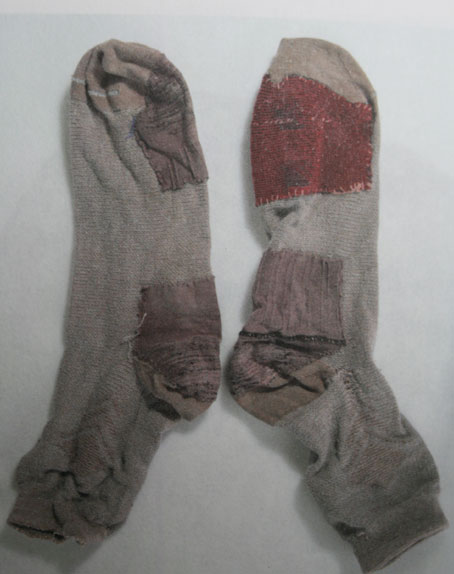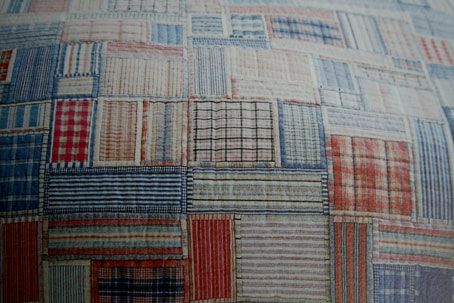I have been making a start thinking about Belle’s quilts. She lived near Blackpool, and the first quilt will be a jolly sea-side-y affair, made up entirely of her stripey tops and T-shirts — of which she had over thirty. In the summer she was always in stripes. I’ve been looking at different methods of piecing and quilting striped fabrics:
. . .and getting lots of inspiration from the way that Jude makes — and writes — about the texture of memory.
Then yesterday I read Vladimir Arkhipov’s Home-Made: Contemporary Russian Folk Artefacts, and it completely blew me away.
Arkhipov is an artist, who, for the past decade and a half, has travelled all over Russia collecting and exhibiting ordinary and marvellous hand-made objects. The objects, and the human stories behind their making, are documented in this super book. The bigger picture here is Perestroika and Russia’s economic and political crises from the mid ’80s to the late ’90s — a period when not not only items of luxuriant or complex manufacture were difficult to get hold of, but when everyday commodities became both scarce and pricey. All of the objects in this book are useful, and the vast majority are born out of necessity — but scarcity and privation are only part of the story here. Arkhipov, and the individual makers whose work he brings to light, show how conditions of necessity produce a particular material grammar; a poetry of ingenuity out of the aesthetics of use.
Here is a poetry of mending quite different from those eighteenth-century darning samplers I wrote about a few weeks ago:

Lubov Arkhipova, Socks, Kolomna (1995)
Arkhipov describes his archive of hand-made objects as “socially responsible art . . . in which people are [authors] of their own histories, histories that have unique illustrations — the self-production of everyday things.” His collection shows individuals as creators not just of things, but of meanings, as each maker accounts for their object in their own words. These short texts and multiple voices often produce intriguing dialogues between the makers and their objects through the narratives, memories, and desires with which they are invested. For example Aleski Solomkin’s contribution to the collection is a doormat made of beer-bottle tops that his neighbour and drinking partner kept flicking over the fence into his garden. Forced to clear up the debris of several evenings’ drinking, Solomkin felt “it would have been a shame to just chuck them all away,” and created an object that, beyond its immediate function, is also a quiet celebration of booze, friendship, and neighbourly-ness.
Many makers also speak persuasively about the pleasure of everyday materials and the creative process. For example, this beautifully made leather cap is formed out of an old Soviet punch bag and a worn out pair of leather boots:

Aleksandr Yakimovich, Cap, Moscow (1993)
Aleksandr Yakimovich talks about how the leather of the punchbag softened up over fifteen years of hard use, and of the “great pleasure” he derived from “making something out of something else” and subsequently wearing it. “Its one of my masterpieces” he says of the cap.
In terms of my own thinking about piecing cloth and memory together, the object I was most drawn to was this quilt made by Galina Svistakova for her son, out of the clothes of his brother, his father and his grandmother.

Galina Svistakova, Quilt, Ryazan (c.1990)
Of this wonderful cloth Svistakova’s son says “I think that things possess the aura of their owners, of a person who may very well no longer be with us, that things all carry information and inform us, and harmonise with other people’s things. I believe they live their own independent lives and that we need to. . . harmonise with them and be sensitive to them, in order for them to work in our favour.” This is the sort of functional poetry I can only aspire towards.


You always make me consider the materiality of things in greater depth. Whether writing about making things, Belle’s clothes and the quilts, or the colours in the landscape that inspired your knitted dress, you have a way of revealing the life and true value, of things.
It is very, very inspiring.
These Russian objects are beautiful and, as always, you have written thoughtfully and respectfully about them.
Thank you.
x
Felix
LikeLike
beautiful post and thanks for the reference. i am so impressed with these extra-ordinary items. re-making is so transforming.
LikeLike
a gorgeous post..i keep coming back to it.
(i discovered you through Rosa :)
thank you
LikeLike
http://www.amazon.co.uk/Quilts-Gees-Bend-Masterpieces-Place/dp/0965376648
the gees’ bend quilters also make extraordinary use of the worn aspect, the inhabited aspect, of the clothes they use for quilts. five stars.
LikeLike
enWezor, so sorry.
http://www.amazon.com/Short-Century-Independence-Liberation-Movements/dp/3791325027
LikeLike
the russians are amazingly soulful. the quote at the end from the son of the quilter is a knockout. and things made by people with nothing whether in the third world or in dictator-mandated poverty approach a transubstantiation thing. i saw armchairs made by africans out of strips of old tires at the p.s.1 museum exhibit of african art (The Short Century, most revolutionarily curated by a brilliant african, Okwui Enrezor) which i have been lusting after ever since. i own a pair of viet cong sandals (inner tubes) which i wish fit me better. etc.
do you know the burlap sculpture of magdalena abakanowicz? she made the most moving sculpture out of glue and burlap (lacking stone or any other artist’s materials) behind the iron curtain in poland.
i might have to get this book. thanks so much for reporting on it. that the makers’ voices accompany the made thing is electrifying.
LikeLike
Beautiful, thanks for sharing these images. I’ve discovered your blog about a month ago and I’m enjoying your posts immensely.
LikeLike